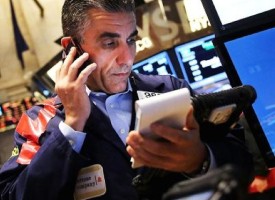The number one worry in the US is inflation. Well, here is what people are doing in the United States to feed themselves.
“Brother, can you spare a pizza?”
May 2 (King World News) – Peter Boockvar: I heard a really interesting perspective on the consumer from my friend Neely Tamminga on a Twitter (X) Spaces I was doing yesterday. Via her consumer surveys and insights she helped to explain why a Domino’s Pizza and Chipotle are doing better than McDonald’s or Starbucks. When a consumer needs to commit $10 for a meal, they feel like they can squeeze out two meals with a pizza pie and a bowl/burrito with that $10 while $10 will only get you one meal at a McDonald’s and Starbucks. This is the extent at which many consumers are budgeting their money.
Again, when reading the following earnings comments, it all continues to sound like one big very mixed bag.
Doordash is showing again how difficult it is to make money in delivery but from a user perspective, they are still seeing strong top line growth.
“In general, we’re not seeing the signs of strain on the consumer, but I think it perhaps has something to do with the segment that we operate in, which is digital and delivery. I do understand that there are some headwinds that certain merchants face when it comes to in-store traffic. But when it comes to all things digital, we’re actually not seeing, I think, those same signs of strains. Even, for example, in the US restaurants business the growth is pretty consistent over the last six quarters.”
Etsy’s revenue barely grew in the quarter y/o/y, the stock is down sharply pre market and said this, “while US unemployment is low and inflation data is mixed, consumer sentiment remains depressed, which some speculate can be attributable to the very high cost of money. Consumer wallets remain squeezed, so there’s often little left after paying for good, gas rent, and childcare. And there’s significant data indicating that the largest e-commerce platforms have primarily been able to grow by selling everyday essentials at very low prices.”
“Macroeconomic conditions also continue to be quite challenging in our other top markets, the UK and Germany. These headwinds are real, do not appear to be abating, and are impacting our sales.”
After going thru some of the revenue trends of the product lines sold on their site, “But overall, we see this as a tale of broad weakness in the types of merchandise we sell.”
eBAY’s gross merchandise sales were also flat y/o/y, with revenue up 2% and said “we continue to navigate through a tough environment for discretionary e-commerce, particularly in the UK and Germany, two of our largest markets.” Exactly what Etsy said. They said the “US is in better shape” compared to Europe.
They said “the macro environment remains challenging and dynamic” when laying out their financial guidance.
When I go thru the earnings calls of Visa (last week) and MasterCard from yesterday, I have in the back of my mind that there is a secular shift to using credit cards/digital payments from cash and these companies live in a nominal world when it comes to retail sales.
They reported an 11% y/o/y revenue growth rate and said “These results were powered by healthy consumer spending and strong cross-border volume growth of 18% y/o/y on a local currency basis.”
Here was their macro view: “the picture remains mixed. First, strong labor markets and solid wage growth remain in countries across the globe. This is supportive of healthy consumer spending. Second, inflation has been moderating with a path towards normalization of monetary policy in most countries. Persistent inflation in the US could delay rate cuts here. And third, geopolitical uncertainty remains in several countries. In addition to these areas, we are closely monitoring the strength of the dollar, commodity prices and consumer balance sheet health. With tailwinds and headwinds to economic growth remain on balance, we are positive about the growth outlook.”
Not only did we get the ADP April jobs report yesterday but ADP itself reported earnings and the stock was up about 2% in response.
They mentioned “the resilient overall US labor market and the fact that our clients continue to add to their workforces at a moderate pace.”
CDW is always an important company to listen to as a major distributor of all things tech, hardware, software, computer peripherals, cloud computing, mobile devices, telecom equipment and cyber products. The stock was down 11% yesterday after earnings.
They said, “Market conditions remained challenging, and first quarter results came in below our expectations…In the 1st quarter, customers demonstrated caution and concern given heightened macro uncertainty weighing on capital investment decisions. At the same time, the complexity of the tech landscape continued to ratchet up, particularly given the additional layer of AI and changes in the IT market landscape.”
“This lengthened decision making as customers deliberated on both how to navigate technology roadmaps and when to spend on infrastructure in a challenging economic environment. While activity was reflected in a solid pipeline, with deals being pushed out, our sales and gross profit lagged. Results were also impacted by the federal budget stalemate, which led to a pause in our federal channel.”
They also said, “we do not expect decision cycles to improve in the near term.”
Shifting to travel, an area of economic strength as we know.
From Marriott:
“Once again, we saw RevPAR growth across all three of our customer segments, group, leisure transient and business transient. Group, which comprised 24% of global room nights in the 1st quarter was again the strongest customer segment.”
International growth outpaced the US and Canada.
As for the outlook, “By customer segment, RevPAR growth is still anticipated to be driven by another year of strong growth in group revenue, continued improvement in business transient revenues, and slower, but still growing leisure revenues. RevPAR growth is expected to remain higher in our international markets than in the US and Canada.”
MGM Resorts mentioned the bifurcation in their customer base. “If I think about Las Vegas first, again, another strong quarter, principally driven by the high end. Although we did see some signs of fatigue at the lower end of the market, overall ADR was up 7% in the 1st quarter and are expecting to hold that range into the 2nd with increased occupancies looking at the 2nd quarter and through the balance of the year.”
As for the Chinese consumer and their Macau business, “Macau, as you all know, for us in particular, but I think for the market, is simply booming.”
They said their regionals business got better as the quarter progressed after the tough winter weather in January.
Shifting to transportation, from CH Robinson:
“And although we continue to battle through an elongated freight recession with an oversupply of capacity, I’m optimistic about our ability to continue improving our execution regardless of the market environment.”
I mentioned yesterday that while the April ISM manufacturing index dipped below 50, it seems that manufacturing is trying to finding a bottom and we saw some signs of that in the overseas purchasing managers indices (PMIs) overseas. Taiwan’s rose to 50.2 from 49.3, Japan 49.6 vs 48.2, Australia 49.6 vs 47.3, Vietnam was at 50.3 vs 49.9, South Korea at 49.4 vs 49.8, Thailand at 48.6 vs 49.1, Malaysia 49 vs 48.4, Indonesia 52.9 vs 54.2, the Philippines at 52.2 vs 50.9 and India at 58.8 vs 59.1.
The Eurozone remains a laggard with its final manufacturing PMI at 45.7 vs 46.1 in March with particular weakness in Germany and France. The UK final was 49.1 vs 50.3 in March and vs 47.5 in February.
© 2024 by King World News®. All Rights Reserved. This material may not be published, broadcast, rewritten, or redistributed. However, linking directly to the articles is permitted and encouraged.







